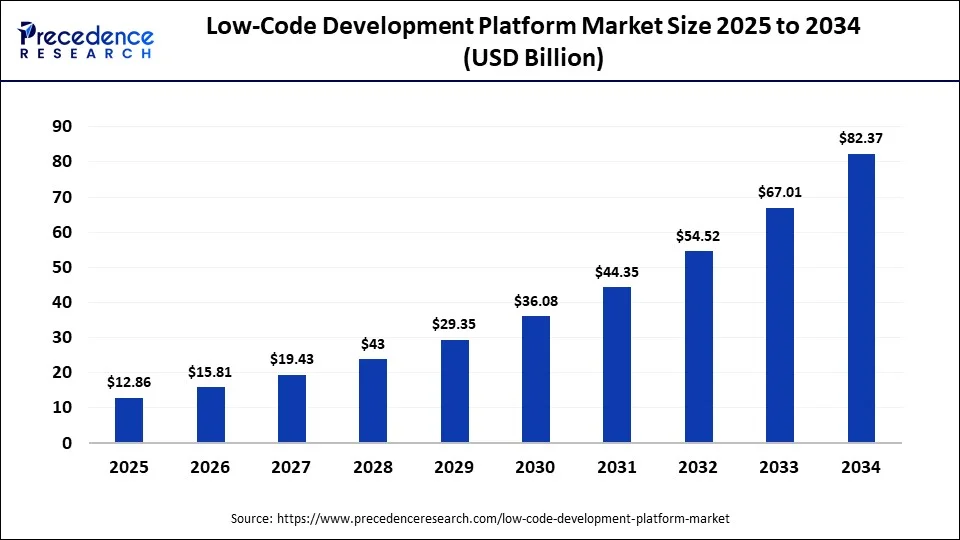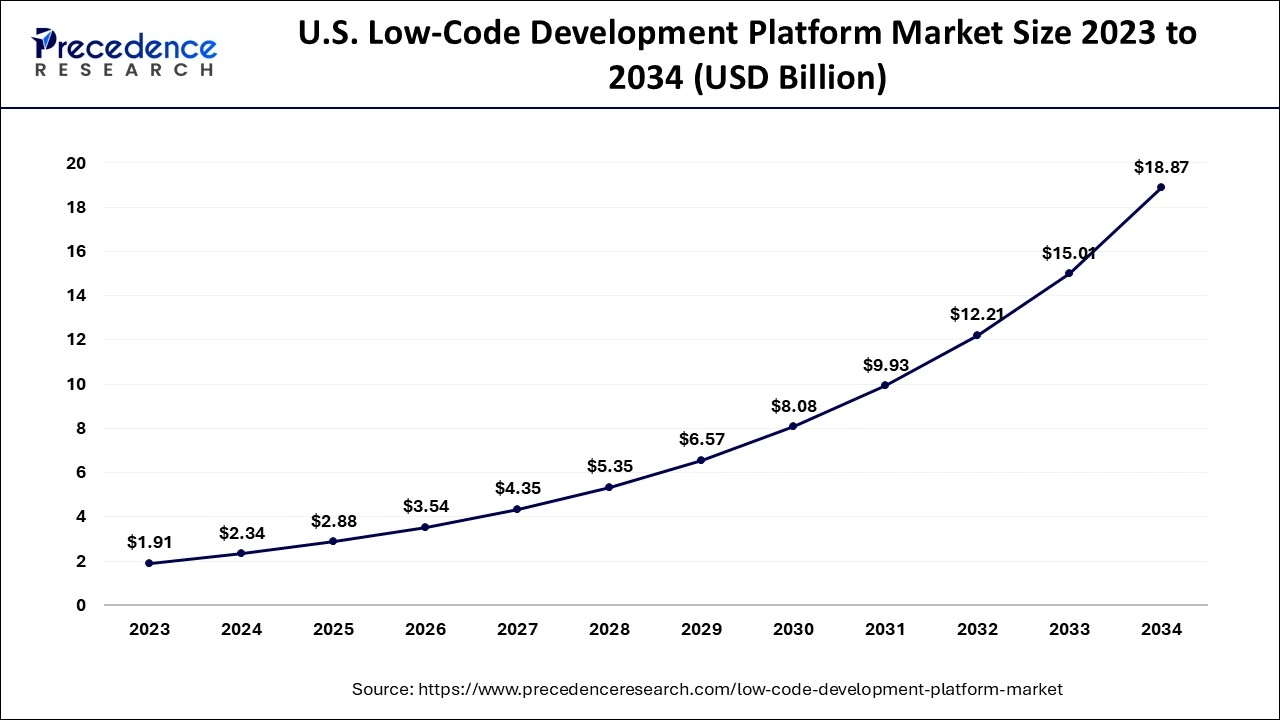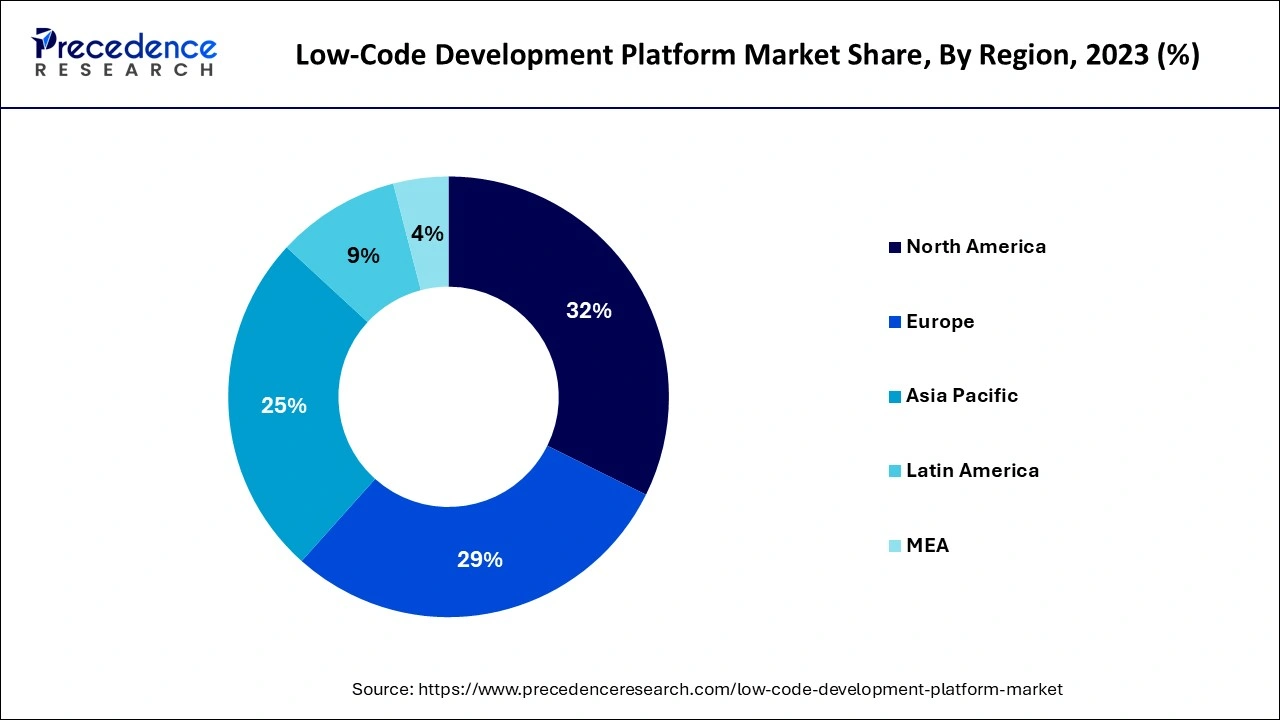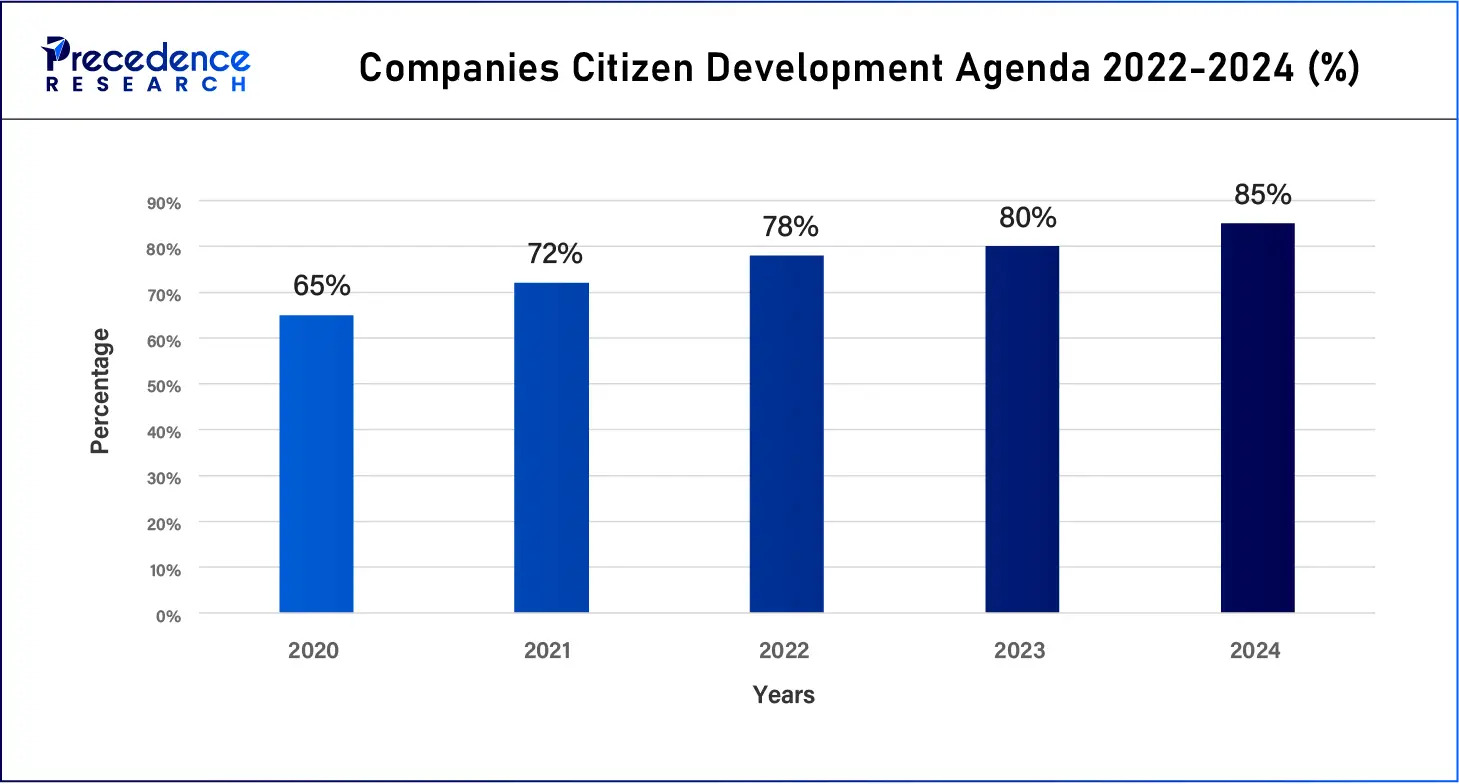October 2024
The global low-code development platform market size accounted for USD 10.46 billion in 2024, grew to USD 12.86 billion in 2025 and is projected to surpass around USD 82.37 billion by 2034, representing a healthy CAGR of 22.92% between 2024 and 2034. The North America low-code development platform market size is calculated at USD 3.35 billion in 2024 and is expected to grow at a fastest CAGR of 23.10% during the forecast year.
The global low-code development platform market size is worth around USD 10.46 billion in 2024 and is anticipated to reach around USD 82.37 billion by 2034, growing at a CAGR of 22.92% over the forecast period 2024 to 2034. The low-code development platform market growth is attributed to the increasing demand for rapid application development and the growing adoption of digital transformation initiatives across various industries.

The U.S. low-code development platform market size is exhibited at USD 2.34 billion in 2024 and is projected to be worth around USD 18.87 billion by 2034, growing at a CAGR of 23.14% from 2024 to 2034.

North America dominated the global low-code development platform market in 2023 due to the strong underpinnings in technology infrastructure and increased need for digital business solutions all across sectors. Additionally, the legal structures enhancing the use of technology in areas such as finance and healthcare have promoted the growth of the market. Businesses in North America are now embracing agility development as a tool for improving organizational operations and customer relations.

Asia Pacific is anticipated to grow at the fastest rate in the low-code development platform market during the forecast period, owing to the continued digitalization strategies and growing smartphone adoption. Developing countries, such as India, China & Japan are also aggressively moving towards technology adoption in sectors of finance, healthcare & manufacturing.
The increasing focus on improving customer satisfaction and operational excellence makes enterprises shift towards the low-code development platform market services that help in quicker application creation. Additionally, the availability of skills in the new generation of employees who are computer savvy and the increase in startups developing innovative solutions elongates this trend.
The need to enhance the speed of application development leads to high growth in the low-code development platform market. These platforms focus on making app development easier, which means that organizations are able to create and launch applications with little to no coding skills. Low-code solutions offer quicker project completion and cheaper development. Companies are now attempting to be more flexible to be competitive.
Moreover, the COVID-19 infection has forced organizations to shift towards the low-code development platform market services by adapting to the new market requirements that resulted from the digital transformation process. Low-code platforms open up modern application development platforms to bring in users to develop custom applications that meet their requirements without any coding knowledge.
Impact of Artificial Intelligence on Low-code development platform market
The incorporation of Artificial Intelligence (AI) into the low-code development platform market has given the industry the blueprint for automating multi-dimensional tedious coding functions. They enable easy and streamlined creation of efficient applications with mere human involvement in the process. AI helps in increasing productivity since it provides coding hinting, smart tracking of all tasks in a project, and quick analysis of generated data, thus minimizing the time required to develop. Additionally, utilizing AI makes it easy for ordinary people to engage in app creation through natural language processing (NLP) and machine learning algorithms to make it applicable across other sectors.
| Report Coverage | Details |
| Market Size by 2034 | USD 82.37 Billion |
| Market Size in 2024 | USD 10.46 Billion |
| Market Growth Rate from 2024 to 2034 | CAGR of 22.92% |
| Largest Market | North America |
| Base Year | 2023 |
| Forecast Period | 2024 to 2034 |
| Segments Covered | Component, Application, Organization Type, Industry, and Regions |
| Regions Covered | North America, Europe, Asia-Pacific, Latin America and Middle East & Africa |
Growing demand for faster application development
The growing demand for faster application development is anticipated to drive the adoption of the low-code development platform market. Companies are seeking agility and the fastest adoption of technology and digital shift. These tools enable the creation of applications with the least time required for development. This is highly evident with organizations that wish to continue competing in the market while endeavoring to launch new software solutions to the market in the shortest amount of time possible. These code platforms make work procedures and tasks easier compared to other traditional forms of coding with device drop and pre-built modules.
Due to the increasing focus on plant and operations optimization, which has the effect of increasing the speed of project completion, this demand is expected to drive the low-code development platform market. Furthermore, a report from the U.S. Department of Commerce admits that the growing adoption of IT modernization strategies in different industries needs to increase demand for low-code platform solutions in fields such as finance and healthcare, which are affected by the need for faster rates.
| Statistic/Fact | Value |
| Increase in Digital Transformation Investment (2021-2023) | 53% growth |
| Percentage of Companies Prioritizing Agile Development | 83% of organizations |
| Reduction in Development Time Using Low Code Platforms | Up to 70% |
| Percentage of Non-IT Employees Engaging in Development | 41% of employees |
| Expected Improvement in Time-to-Market for New Applications | 3 to 4 times faster |
| Estimated Increase in Developer Productivity with Low Code | Five times more productive |
| Percentage of Organizations Reporting Faster Project Turnaround | 77% |
Integration with legacy systems
Organizations have their basic structures that do not neatly integrate with the new low-code solutions. In the low-code development platform market, this lack of compatibility results in barriers during implementation, leading to time delays and the cost that may be incurred in reconciling the existing and the new systems. It is expected that the failure to integrate these platforms with other existing systems will be due to the efforts made by the enterprises to simplify their processes.
Integration with legacy systems poses a significant challenge for the adoption of low-code development platforms, which is expected to hamper the low-code development platform market. Across many industries, governments, together with their associated regulatory bodies, still operate utilizing overly complex and often antiquated infrastructures that are challenging to maintain. Furthermore, the process of integrating the various technologies is also challenging, adding to frustrations within different project teams.
Increasing adoption among non-technical users
Increasing adoption among non-technical users is expected to spur the low-code development platform market expansion in the coming years. Low code platforms make application development easy for people who do not possess coding skills, thus bringing software development to industries of all types. This expands the user clientele to include common clients, including business analysts and managers, to articulate the application based on operating requirements. Leveraging smooth interfaces, immediate feedback, and robotic process automation, these technologies enable employees to participate in creating and disseminating digital assets independently of technological support provided by IT departments.

The platforms segment held a dominant presence in the low-code development platform market in 2023 due to the increasing pressure of the demand to create applications that are fast and deployable. Businesses are always in a continuous search to improve their efficiency, which puts pressure on making their software development processes effective. This creates growing interest in platform-based solutions that enable the creation of applications with minimal coding. Hypertextual terminals, together with built-in templates and reusable components, help businesses create applications that meet their requirements easily.
The services segment is expected to grow at the fastest rate in the low-code development platform market during the forecast period, owing to the rising need for help, coaching, and implementation services that come with the use of low-code platforms. Organizations are getting the help they need to refine their development processes to accommodate low code or implement a low code solution into the organization’s infrastructure.
The report by the International Data Corporation (IDC) indicates that firms that are investing their capital in digital services are poised to see improved operational performance and productivity, hence the need to hire specialty consulting and technical services. As stated by the U.S. Department of Commerce, the incoming demand for many training services is driven by the mission of organizations and other enterprises. That strives to provide non-technical users with the necessary skills to properly use low-code tools to develop applications.
The large enterprises segment led the global low-code development platform market due to the ample funds and the pressure from the COVID-19 pandemic that forced organizations to integrate digital strategies into their business models. These types of organizations are majorly shifting towards low-code solutions to cater to their complicated business processes and enhance multi-departmental performance. Big businesses have concerns with extensibility and compatibility issues, which makes a popular flexible platform that allows integration with other systems that makes low code quite appealing.
Furthermore, the capability of deploying applications rapidly enables such organizations to meet market changes and customers’ demands adequately. The rising importance of using data in the processes also benefits the advancement of low-code platforms, which help large enterprises use real-time data for strategic planning.
The small and medium-sized enterprises (SMEs) segment is projected to expand rapidly in the low-code development platform market in the coming years, owing to the growing demand for efficient and cheap solutions that help to develop applications quickly. SMEs are utilizing low-code platforms that are feasible solutions since non-technical users develop applications using little coding skills. The flexibility and ease of use inherent in the platforms enable SMEs to respond to market conditions and act on such issues with relative ease. Additionally, the low-code platforms offer SMEs the flexibility to improve customer relations and drive efficient business processes without necessarily paying a lot of money.
The BFSI segment dominated the global low-code development platform market in 2023. Low code solutions are being adopted by financial institutions to address efficiency, compliance, and user interface issues through the building of applications that automate business processes. The increasing focus on digital banking, coupled with new entrants from the fintech space, has put pressure on BFSI organizations to follow new development paradigms. They are able to adapt quickly to the dynamic nature of rules and policies and end customer demands.
Additionally, the use of low code brings about less time and capital needed to develop applications, which in turn enables BFSI companies to deliver customer-centered applications. The enhancement of digital platforms to minimize cost and increase customer satisfaction is primarily required by banks and insurers, making low code development platforms preferable.
The healthcare segment is projected to grow at the fastest rate in the low-code development platform market in the future years, owing to the rising need for patient engagement and efficient use of health system resources. Healthcare organizations are finding that low-code platforms allow them to build the types of applications that extend and improve engagement with the patient. This enhances the efficient management of operations and increases the sharing of information across providers. According to the World Health Organization, the current and future prominence of digital health solutions will enhance healthcare delivery and its outcomes.
The web-based segment accounted for a considerable share of the low-code development platform market in 2023 due to the growing demands for easy and scalable solutions and services. Companies prefer web-based applications, as they run on multiple devices and platforms without requiring heavier installations. Such flexibility helps the business to release updates and new features fast, which keeps the users always engaged with updated content. Moreover, the rising focus on digitization by companies, especially in solutions that improve customers’ experience and internal processes, further boosts the segment.
The mobile-based segment is anticipated to grow with the highest CAGR in the low-code development platform market during the studied years, owing to the increase in the use of mobile devices. Most consumers have embraced the use of mobile devices, especially smartphones and tablets. It makes organizations focus on mobile development to meet clients and customize communication to improve overall interaction. Due to its low code feature, the utilization in the generation and management of mobile applications enables businesses to respond dynamically to the needs of their users in a shorter time. Furthermore, by incorporating social networking to follow this trend, any organization is able to extend its market base and the way it communicates with the customer base, which further necessitates the utilization of low-code development platforms for mobile applications.
Segments Covered in the Report
By Component
By Application
By Organization Type
By Industry
By Geography
For inquiries regarding discounts, bulk purchases, or customization requests, please contact us at sales@precedenceresearch.com
No cookie-cutter, only authentic analysis – take the 1st step to become a Precedence Research client
October 2024
January 2025
February 2025
December 2024